Originally appeared at ZeroHedge
Update: just moments after our write up on how much depends on OPEC+ getting a deal done (including, among other things, Trump’s re-election chances) there was virtual white smoke pouring out of OPEC+’s virtual chimneys, when Bloomberg reported that after a week-long marathon of bilateral talks and four days of video conferences with government ministers from around the world, an “historic” agreement finally emerged to cut oil production in a world suffering an unprecedented plunge in energy demand.
Just hours before oil resumed trading on Sunday, energy ministers of global oil producers agreed to cut oil production but not by the 10MMb/d announced previously, but rather by 9.7MMb/d as Mexico won the long-running standoff, and will be required to only cut 100,000 despite Saudi Arabia’s vocal objections, with the US somehow contributing the balance.
“OPEC+ will cut 9.7 million barrels a day — just below the initial plan of 10 million. Mexico appeared to have won a diplomatic victory as it will only be required to cut 100,000 barrels — less than its pro-rated share”, Bloomberg reported. This means that the 4-day Mexican standoff between Mexico and pretty much every other nation, has ended with Mexico victorious and Saudi Arabia’s reputation to enforce a deal in tatters, in no small part thanks to Mexico’s “secret weapon” a multi-billion oil price put that insulated Mexico from further oil price declines.
This means that in a world where there is now up to 36MMb/d less oil demand, the world’s oil producers have agreed to cut production by… 9.7MMb/d.
It also means that starting May 1 (obviously no need to rush here at all) the world’s oil production will look like this:
Or rather, it won’t look like that because the table assumes non-OPEC nations – besides Mexico – cut by 23%. That won’t happen, as we now learn that the US will cut 300,000 bps on behalf of Mexico, but not pursue any of its own cut.
And while Bloomberg has blasted the following headline:
- U.S., BRAZIL, CANADA TO CONTRIBUTE 3.7MBD TO OUTPUT REDUCTION
That said, the US will not contribute anything besides offsetting the 300K in Mexican cuts, in the next few months….
- NIGERIA SAYS U.S. PRODUCERS TO CUT 300K B/D AS PART OF OIL DEAL
… as the US position has long been that US output will decline organically by 2mmb/d over the next two years as it is unable to do so from a legal basis. Of course, if oil prices do rebound, none of this decline will ever happen as US shale ramps up again, which means that the US is getting a free pass once again however with the US now the biggest producer, this simply means that today’s deal will be forgotten in weeks if not days.
Additionally, as Bloomberg’s Julian Lee writes, the deal raises some even bigger questions than Mexico. Russia, for example, is to cut its output by 2.5 million barrels a day over the next three weeks. Good luck with that:
Really? Igor Sechin, head of state-controlled oil company Rosneft, was a fierce critic of Russia’s modest contribution to previous reductions. I can imagine how he’ll react when he’s told his company has to cut output by almost 1 million barrels a day by May 1.
The question now for the oil market is whether the cuts will be enough to throw a floor under prices as demand for energy craters. Amid a record plunge in demand, the result of the global economic shutdown, the oil market is now far more worried about consumption than supply. OPEC itself acknowledged the challenge, with its chief warning ministers demand fundamentals were “horrifying.”
OPEC+ was also seeking 5 million barrels a day of output reductions from producers in the Group of 20. The group, however, didn’t mention any curbs in its communique following a meeting on Friday, only saying it would take measures to ensure stability. India’s minister mentioned filling the country’s strategic oil reserve, but there were no concrete new offers from the group. With oil prices on the floor, building up reserves makes sense anyway, and China and India have already started. But storage space is limited.
The U.S. has room for another 77 million barrels in its Strategic Petroleum Reserve, but Congress refused last month to approve the budget for an initial 30-million-barrel purchase. Oil traders and analysts estimate that China could buy an extra 80 million to 100 million barrels this year. Meanwhile, the Indian government is asking state-run refiners to buy 15 million barrels of crude from Saudi Arabia, the United Arab Emirates and Iraq to fill its tanks. Beyond those three countries, there’s little storage capacity elsewhere.
U.S. Energy Secretary Dan Brouillette told the G-20 meeting that the oil market collapse will impose some 2 million barrels a day of American output cuts by the end of the year without any government intervention. Some predictive models, he added, see the drop as big as 3 million barrels. Russia previously rejected such “free market” cuts, arguing that production falling in response to a lack of demand is not an output reduction. But in the end it capitulated, along with the other OPEC+ countries. There was no mention in the OPEC+ communique of the deal being dependent on the actions of anyone else outside the group.
Putting it all together, this means that today marks the second time in less than five years that Saudi Arabia’s attempt to pursue a pump-at-will policy has collapsed. After just one month, this one has lasted an even shorter time than the previous effort, brought to an end by the OPEC+ deal with Russia and other countries toward the end of 2016. Meanwhile, the math is that if one ignores the diplomatic sleight of hand and math gimmicks, the production cuts amount to just over 7mmb/d, which while still a record amount, are hardly enough to put an even modest dent in today’s massively oversupplied market.
Which brings us to Julian Lee’s ominous conclusion: “with an unprecedented demand collapse. Don’t be surprised if the war over market share between the Saudis, the Russians and the Americans resumes once the lockdowns ease and people want oil again. This is probably a temporary truce rather than genuine peace between the three biggest producers.”
It probably is, but Citi’s Edwards Morse, who moonlights as a special advisor to OPEC, wasted no time in upgarding his oil price from $25 and $29 for Q3 and Q4, to $35 and $45 respectively…
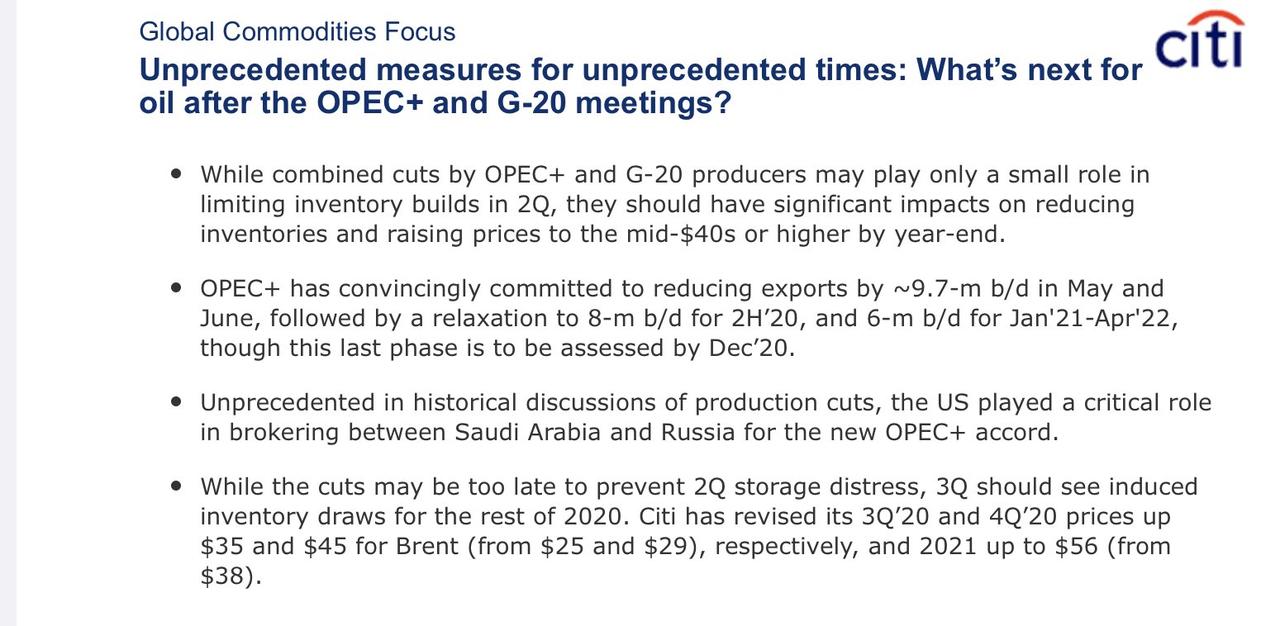
… even as Goldman’s Damie Couravalin expects today’s deal to achieve nothing with Brent set to slide back to $20/barrel.
Given the difficulty for most producers outside of core-OPEC to implement large cuts, an even bigger headline cut at the G20 meeting would not change such an inevitable outcome, as we discussed yesterday.
- First, the equitable c. 23% country level cuts used by OPEC+ (instead of the typically higher core-OPEC share) allows for a large headline cut but also implies lower compliance.
- Second, it leaves the effective voluntary cuts too small to avoid breaching storage capacity, ensuring that low oil prices force all producers to contribute to the market rebalancing with some of the shut-ins likely to prove persistent, creating a faster oil rebalancing.
We therefore reiterate our view that such cuts, if agreed upon tomorrow, would still be too little and too late to prevent a decline in prices in coming weeks as storage capacity becomes saturated. Ultimately, this simply reflects that no voluntary cuts could be large enough to offset the 19 mb/d average April-May demand loss due to the coronavirus. Such an outcome was already visible today, with the large Cushing crude inventory build reported by Genscape driving a further collapse in May-June WTI timespreads to -$6.0/bbl. We expect further weakness in WTI timespreads and crude prices in coming weeks, with downside risks to our short-term $20/bbl forecast (especially if a deal is not reached)
One of two will be wrong.
* * *
EARLIER:
Perhaps due to ideological principles, perhaps due to its massive oil hedge that stands to make billions in profits if oil stays at its current depressed prices or drops further, perhaps because Mexico’s president AMLO plans to revive Pemex and so is unable to cut oil output, but four days after OPEC+ announced it had “reached a deal” in which all oil producing nations, including non-OPEC G-20 members would cut production by 23%, Mexico is still refusing to sign the dotted line and is threatening to trigger another oil price crash when the black gold reopens for trading in a few hours.
To be sure, there were some signs of progress with Bloomberg reporting that as diplomatic wrangling between Mexico and Saudi Arabia entered a fourth day, a group of OPEC+ ministers were due to speak at 5 p.m. London time and delegates said two possible fixes would be discussed. However, as Energy Intel deputy bureau chief Amena Bakr, writes, almost an hour after the scheduled call, Mexico’s energy minister Rocio Nahle had yet to join the call.
Sources say that Mexico’s minister isn’t on the call yet #OOTT #opec
— Amena Bakr (@Amena__Bakr) April 12, 2020
And as the world wait, the stakes are getting higher by the hour: oil prices have already collapsing under the weight of an oil glut that amounts to about a third of the market’s overall size, as the coronavirus pandemic has shut down the global economy and sent India’s oil demand plunging 70%. That’s threatening the U.S. shale industry, wrecking the budgets of oil-dependent nations and making it harder for central banks to respond to the virus shock; it has also made Trump an especially activist participant in this negotiation which he is hoping works out as Trump knows very well that without Texas his reelection odds will follow the price of oil.
That has not escaped the Kremlin, which earlier today warned of “unmanageable chaos” if negotiations fail. “The whole world needs this deal,” Dmitry Peskov, spokesman of President Vladimir Putin, said in comments broadcast on Sunday, while also hinting that Trump may have the most to lose if a deal is not reached: “With layoffs looming for the U.S. oil industry and shale oil companies on the brink of bankruptcy, the nosedive in crude prices acquires political significance as U.S. elections approach”, Peskov added ominously.
The OPEC+ alliance on Thursday agreed a plan to cut its output by 23%, or 10 million barrels a day, equal to a 10th of global supply. The deal would end the month-long price war between Saudi Arabia and Russia. However, it still needs the approval of Mexico, which is part of the alliance, but until Sunday had yet to endorse it. Mexico has agreed to cut just
On Sunday’s call delegates expected a compromise solution proposed by President Donald Trump last week – initially rejected by Saudi Arabia – would be discussed again. Another idea has also emerged, to focus on Mexico’s exports rather than production. Negotiations then escalated to the highest level, with Trump intervening to speak to leaders including Crown Prince Mohammed bin Salman.
Late last week, a deal looked close until Mexico raised objections. Populist president Andres Manuel Lopez Obrador has pledged to restore his country’s oil-pumping prowess with its politically symbolic state oil firm, and so he is reluctant to cut output. Trump offered a compromise – by which U.S. cuts would count as Mexican – but it was rejected by Saudi Arabia. Talks between the kingdom and Mexico continued through the weekend as no a single nation was willing to back down from the Mexican standoff.
Confirming that Trump is especially invested in getting some deal done today, in an attempt to break the impasse, the US president offered a diplomatic solution that includes some “creative accounting” with Mexico counting some of the U.S. market-driven supply decline as its own. According to delegates, most OPEC+ countries back the Trump compromise – even if they acknowledge it’s a face-saving mechanism that doesn’t translate into actual cuts. But Saudi Arabia insisted that Mexico cut its production as much as everyone else.
That said, even if a deal is reached – and one likely will be – it may not be enough to put a floor under oil prices. While a 10% reduction in worldwide crude output would be unprecedented, it would barely dent the surplus that continues to build and has reached as much as 36 mmb/d of global demand according to Trafigura.
Needless to say, traders will inspect any agreement for details of where real cuts are coming from, and how much of the headline figure might come from moving baselines and reductions that have already been forced on producers by the market.
On Friday, G-20 nations followed the OPEC+ meeting and said they would take “all the necessary measures” to maintain a balance between oil producers and consumers, but made no commitment toward specific steps on production cuts.
Riyadh had wanted the G-20 meeting to yield at least 5 million barrels a day of cut commitments from producers outside OPEC+, however it is now clear that the only production cuts the US is willing to shoulder – besides what the administration has defined as organic cuts over the next two years as some 2mmb/d in shale production are eliminated – are those to backstop Mexico. The reality, as shown in the table above, is that real cuts when ignoring accounting gimmicks, amount to just over 7mmb/d, still a record amount, but hardly enough to put an even modest dent in today’s massively oversupplied market.



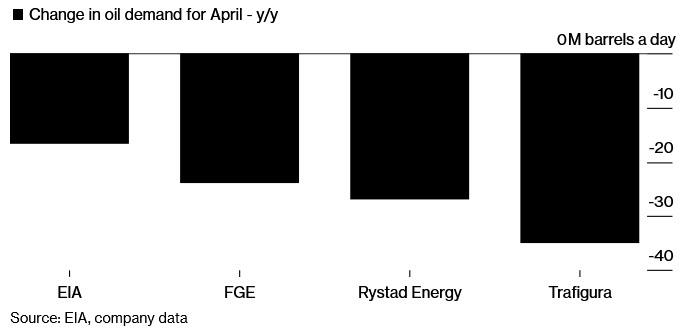
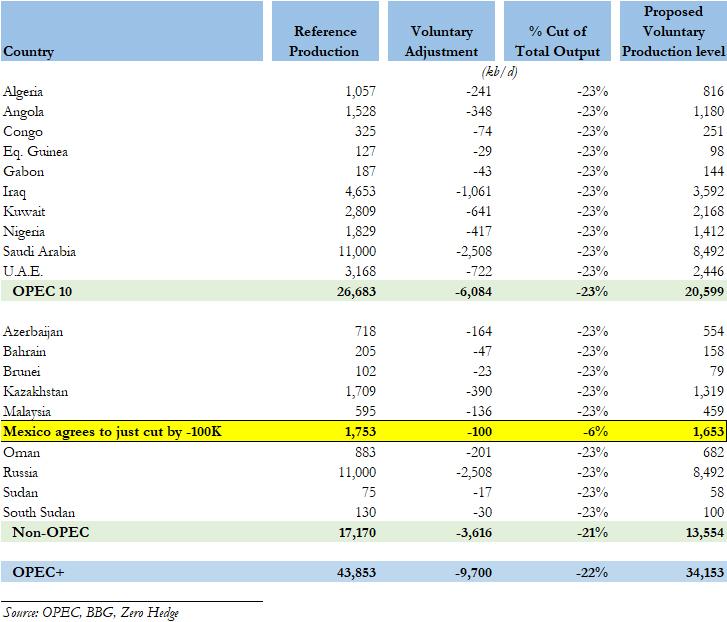
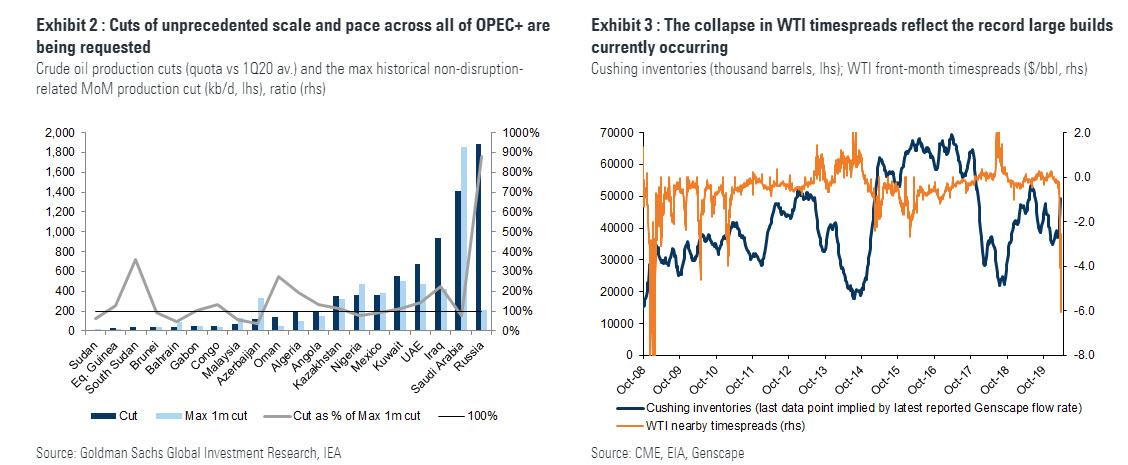
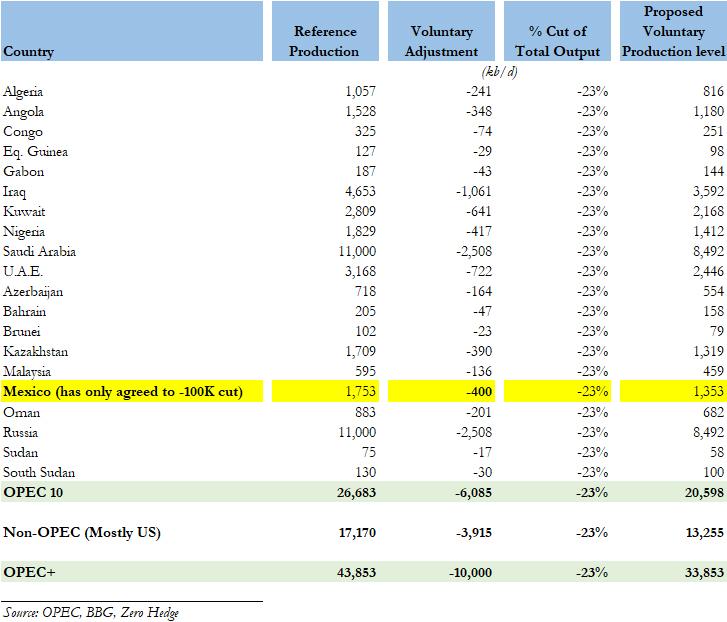



Here is the whole list. https://en.wikipedia.org/wiki/List_of_countries_by_oil_exports
So far the consumers are the winners, which is very good in a regression.
I dont like people use “collapse”. I see greedy oilproducers striiping me, whereever they can. USA has made itself into an exporter but by minus profit in lowered prices. Whar wrong with You Trump. You just close those new ones and open them again, when the price again is up.
The USA user dont care at all. They are like everybody else and love to buy cheep just as me.
I love the regression as well.
When its only growth its like cars and on the speeder but no steerwheel. So I hope for quality growth for some years, where we all do Our best to be more effective producers as well as consumers.
The only loosers are the poor. Now they can drive more in their ancient smoking cars driving 11 km pr liter and more smog in such neighborhoods already wit no fresh air´probatly will make those poor die faster – but with a smile :)
High Corona from here…
Heu moron,we deafeated corona in oz,you know i like my v8 cruising at 80 mph/aircond on overtaking every selow incumbent driver along the way whilst averaging 5.2 litres per 100 km!
oh and the great deal on new corvette $58,900 0-60 @2.8 seconds much more refined than ye boaty outdated inferior musk gogo mobiles,which in term cant handle nor brake proper on the race track,where as the vette identical track times to your much too expensive european porshe rs3 indeed!
So what does this mean? Everyone benefits old or new,where as soros/assfloggeds living in highrise apartmenst infest in deseases there in californication land,Austalians with much more generous living standards have ridded the virus,fuel has never been cheaper since ye cheney hero pranked 911 back then,you covert nazism kweers got no more answers no matter what
and the best part about it i am more envirometally friendly than all you beggoted floggeds
ranting on lies about clean air where infact you incest spawn liar wannabes are the polluters!
All petro chemicals kill bacteria=FACT,personally 40 years of factual proof!
Folks happily married over 2/3rds century,life is good when you enjoy in v8/turbo as well ok!
To be clear the poor will benefit and the loser never can predict on the soros take n fake shares n scams lose (period)
HIGH RISE CORONA,YOU demoncrats GOT IT THERE ALLRIGHT!
See jealousy is a curse,cursed thy cursed,so be it,personally I’m glad I ain’t you even fkdup!
Your unsolicited comment?best let truth be the better judge in judgment,just saying:
the price continue to fall
So the US is off the hook, again; no official agreement by Trump and he will go back on any “deal” he has made, another cheap poker game.
No the opposire is taking place,however that can only be a good thing for the end consumers!
Not good where I live; prices gone up.
I dont know where You are.
Our prices are higly regulated by the world prices but most of it is tax by the goverment.
Our car fuel has lowered about 20%.
I see the “of the hook” as a very temporary solution. The Covid does we lower the activity and has to restart a lot.
So the consumption for oil and gas probatly will go more down and then we are back in no one will buy expensive oil as well as the mainproducers cant even sell their cheep oil.
I am no expert. In weather I am a hand out of the window. If its wet, its raining.
Zero hedge can fk0ff,the fact remains no one needs opec (period) Every nation can deal in merit,
all us blends prices down by alot as the world realigns in the turning of the tide to prosper freedom,not incumbent hegemon,either way,the prices will fall,this means war,now lets see how these creepy cokheaded fearmonging tyrant wannabes deal with the the real world here on in,now great fuel deals!
Looks like orgasme by Your behind. Very good computers can bring smoke yet.
so far very little effect on wti, up 45cents to 23.21 bucks/barrel and brent up 28 cents to 31,76 bucks/barrel. the deal won’t do much considering that the drop in consumtion is down some 30million barrels so a cut of 10 million barrels wont make anyone happy, n.b. than the disintegrating states of A is not obliged to cut anything but dunny the dunce promises that there will be an organic reduction in the shale business over the next couple of years which most likely is a bold faced lie since a few of the less profitable ventures will disappear but the concentration of operations into the hands of the big guys, say exxon, chevron and so on means that they will drill better acreage and thus increase the output. surprised that russia and saudi went for such cheapo teic a la dunny the dunce – the man of the deal whoahahahah
I agree. The effect is too low. But is it a relevent discussin at all. I dont think most of that is. OIl is only a small part of the world market.
US won this round. Russia refused to cut 1.5m b/d hence the oil war with the Saudis. Now Russia is cutting 2.8m b/d whereby the US follows the market trend. Doesn’t look like Russia made a smart move.
https://www.al-monitor.com/pulse/originals/2020/04/russia-us-saudis-opec-oil-deal.html
Nice made article, but I would not rely on that source for this and a lot of other things.
We are in a small regresion and add covid. LOwering the production fx 23% is not enough for almost anything.
Russia probatly cant sell more oil in the regresion. USA cant sell the thracking oil and therefore is no winner as well.
The only winners are the consumers but in a regresion market, where we by that are compensated some fx forbeingless employed and lowered saleries.
Russia as well as other counties having economies with only one leg are the loosers. I agree in hat conclusion but others has to be added to Russia to see the whole picture.
By that You can say USA is a winner but a relative.
I know fokus here is oil/fuel but several countries has vital problems having old machinery added to much sand.
For USA I would say, that they get Biden but they need Sanders. We know ostriches keep their heads low, but its not for hiding for the realisme. They listen. No one listen here and make the needed changes.
We see almost the same for EU. We are the only ones having a big plan for energy use, but its slowed down by more or less stupid unrealisme by several members. Now we see we for a period will get almost free oil, which will delay those many good initiaves, where we already has Nordstream too as omportant factor. We also see a gas pipeline from Norway.
So I am worried. Iam also worried for the unfair conpetition by China. They produce a lot and under any price we can make it to and roo much is shiiit too.
Its more important for the world to get even competition with China then that oil.
To me its also a matter of quality in stead of quantaty We have to reduce smoke, noise and make less garbage, we cant recycle in a sober way.
I am fine with growth, where we win by proding BETTER not just more.
OPEC is a cartel and should be disbanded. They operate the business for maximum profit and just as De Beers controlled the supply of diamonds to jack up the price of something one can find laying all over the closed beaches in western Africa, some producers want to squeeze supply and make the public pay more for their fuel.
If suadi’s weren’t so wasteful or extravagant, they could survive on lower oil prices.